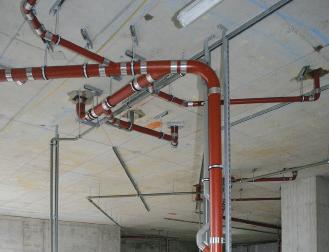
4 minute read
Inherent Fire Performance
Introduction
In drainage installations, safety in case of fire is the primary health and safety concern, both in terms of material properties and reaction in fire, and fire resistance to prevent collapse. The modern, lightweight cast iron of the Harmer SML system offers marked benefits over plastics-based drainage materials and is CE marked.
Superior Performance and Safety in Event of Fire
Harmer SML cast iron pipework is non-combustible and fire safe – cast iron is the ideal material to promote fire safety. In drainage applications, particularly above ground, resistance to fire is the most essential safety requirement – both with regard to reducing risk of damage to the building structure during a fire, and contributing to safety in routes of escape.
The Harmer SML soil and waste system has been extensively tested for the Reaction to Fire under BS 13501-1. This incorporates BS EN 1716 “Heat Combustion”, BS EN 13823 “Single Burning Item” and BS EN1182 “Non-combustibility” achieving the following results:
The Harmer SML soil and waste system has been extensively tested for the Reaction to Fire under BS 13501-1. This incorporates BS EN 1716 “Heat Combustion”, BS EN 13823 “Single Burning Item” and BS EN1182 “Non-combustibility” achieving the following results:
1. Cast Iron material classification A1
Non-Combustible - Reduced Risk of Flashovers
Because cast iron pipework is non-combustible it does not contribute to deadly flashovers, which can engulf a space with flame in seconds. Flashover is a phenomenon of near-spontaneous ignition, occurring when organic materials are heated and undergo thermal decomposition. This causes a release of flammable gases that lead to simultaneous ignition of combustible materials in any enclosed space. Flashover is a dangerous phenomenon, much feared by fire fighters, who are specially trained to deal with and mitigate the danger from shooting flames during flashovers.
Flashover effect
No Flaming Droplets
In fire, plastic pipework can melt and ignite to form flaming droplets, which can fall from burning material to initiate new fires away from the original point of ignition. Flaming droplets can pass through and spread fire downwards to different parts of a building via plastic pipework, even where fire collars are correctly installed (see diagram below). There is no such risk of fire spread to lower stories when Harmer SML cast iron pipework is installed, and the functionality of a drainage system is maintained throughout a fire if it is cast iron.

Fire Test with Plastic Pipes with Correctly Installed Fire Collars
Flaming Droplet Spread Sequence
Beginning of the test
After approximately 10 minutes
Flaming droplets despite correctly installed fire collars
After approximately 20 minutes
Ignition of the pipe bend in the storey below - fire transfers downwards
Minimal Smoke Generation
Being non-combustible, cast iron does not burn or generate smoke in the usual sense. Any smoke generated by heat effects on the inner coating of SML pipework is contained within the drainage system and evacuated to the exterior through roof vents.
Minimal Length Expansion
Cast iron has a low coefficient of linear expansion, far lower than that of plastics-based pipework, and any expansion of Harmer SML pipework through heat will be accommodated by the system couplings. With plastics-based pipework, special expansion compensators are required.
Resistance to Fire of Pipe Penetrations
When installed in a building, all water, sewage, heating, gas, ventilation or electric lines will have to penetrate ceilings and walls with a fire resistance requirement. However, penetrations through ceilings and walls are only allowed if the fire resistance of the ceiling or wall is not impaired. Therefore, pipe penetrations must have at least the same fire resistance duration as the ceiling or wall.

Pipe penetrations will be classified for: Integrity (E) Insulation (I)
Throughout Europe, tests for fire resistance of pipe penetrations are based on the test standard EN 1366-3.
Pipes are installed in a furnace, with penetrations through the ceiling and/or the wall of the furnace. With gas or fuel burners, the furnace is heated to a temperature of approximately 1000ºC. The standard requires a certain temperature curve and pressure to be maintained.

The test will monitor:

Integrity (E) by observation. Flames and smoke may not exit through the pipe penetration.
Insulation (I) by temperature sensors in defined places on the ceiling and the pipe outside the furnace.

The temperature outside may rise by no more than 180ºC peak value and no more than 140ºC average value. Some typical fire-proof constructions








